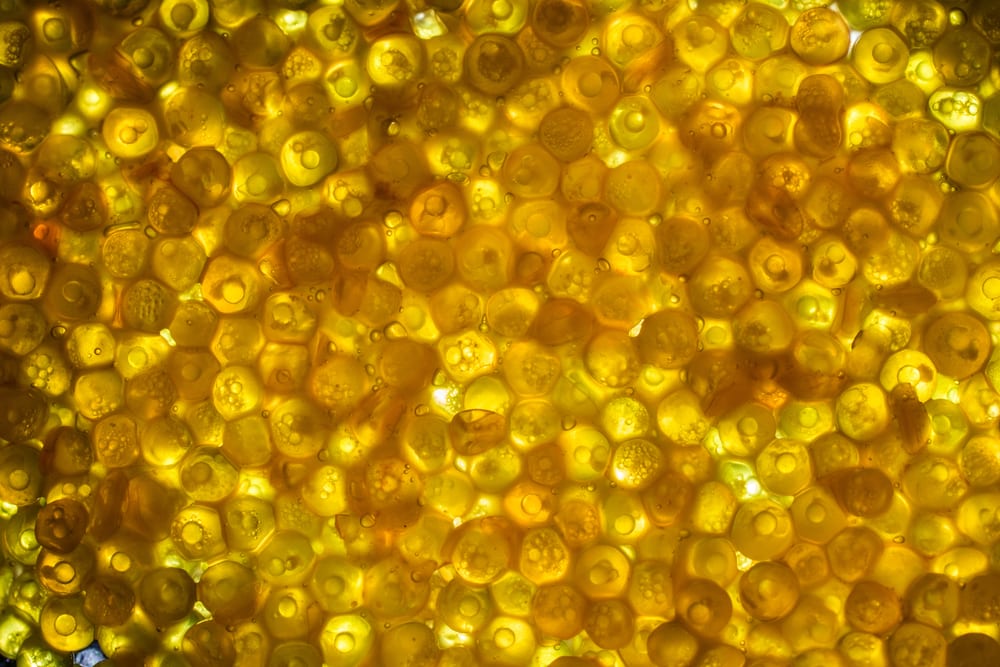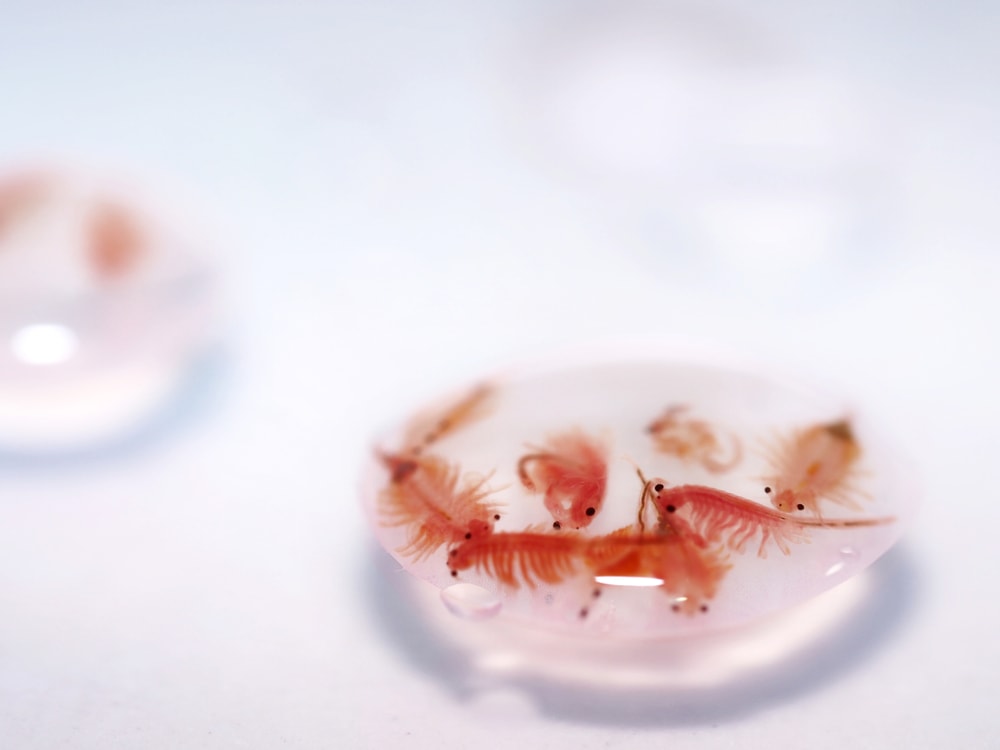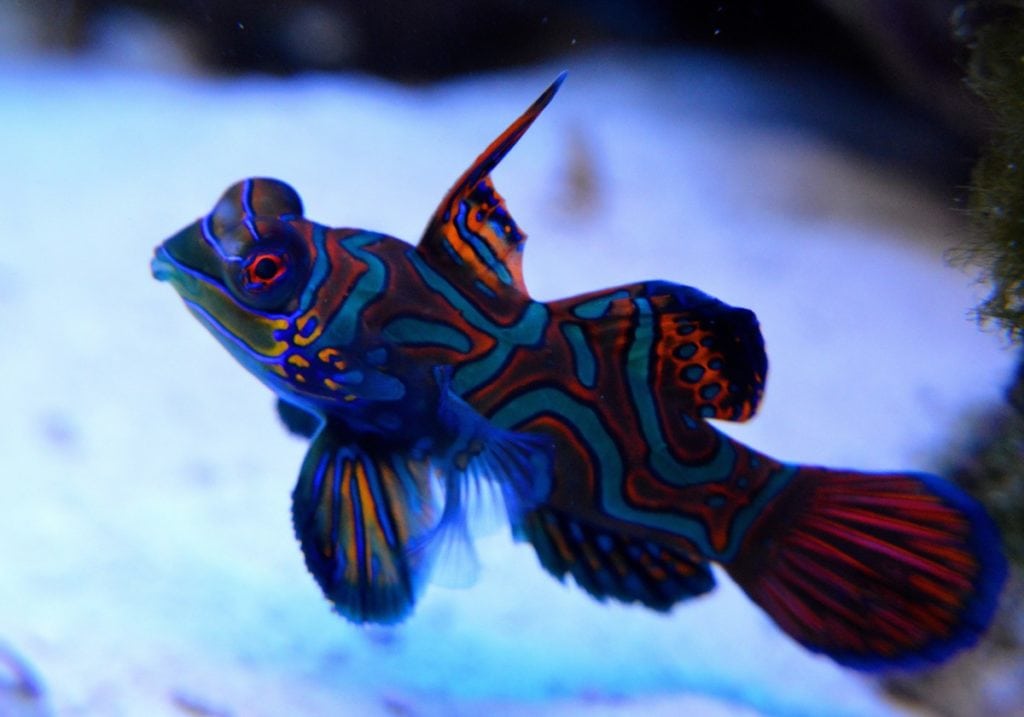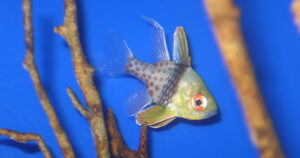For so many aquarists, the green mandarin fish (Synchiropus splendidus) is a must-have species. Its endearing personality, exquisite finnage and intense coloration rarely fail to impress. Given these highly desirable traits, it has for long been among the most popular marine aquarium fishes. Thus, many thousands of specimens of this species are sold in the ornamental fish trade each year. Most of these are wild caught. This is unfortunate, as wild caught individuals have a rather poor record of survivability compared to captive-raised individuals.
 This for a number of reasons. For one, the mini-spears that are used to harpoon wild individuals during capture frequently cause serious internal injuries or infections. Moreover, this species often suffers from malnourishment after being subjected to the typical fast during transport. By the time a mandarin arrives at the retailer, it may be (even with the most devoted, professional care) beyond the point of no return.
This for a number of reasons. For one, the mini-spears that are used to harpoon wild individuals during capture frequently cause serious internal injuries or infections. Moreover, this species often suffers from malnourishment after being subjected to the typical fast during transport. By the time a mandarin arrives at the retailer, it may be (even with the most devoted, professional care) beyond the point of no return.
For these reasons and more, it is always a good idea to opt for an aquacultured mandarin fish. One could argue that it is always better to go with cultured livestock; but in the case of mandarins, the difference between captive-raised and wild are enormous. The biggest, and most notable, difference here is in their feeding habits.
Wild caught specimens might eventually begin to feed, but never accept anything other than live foods. Some wild individuals might not ever resume feeding in the aquarium at all, perishing in very short time. Individuals that have been raised in captivity, on the other hand, are far less finicky. They are comparatively voracious eaters, even greedily accepting frozen (that is, dead) items such as cyclops, small mysis or baby brine shrimp. Being completely reared in an aquarium environment, they even might arrive already trained to feed on prepared items such as fish pellets. Opportunistically nabbing these extra food items when available will afford the animal a few extra, precious calories; it will not, however, provide a substitute for the continuous availability of live items such as copepods.
[LiveFoods]
From the shape of their mouths to the function of their digestive tracts, mandarins are specially adapted to feed on microcrustaceans such as copepods and amphipods. While studies have revealed that mandarins prey on a fairly wide variety of critters (even baby snails), pods always form the bulk of their diet. Because their prey is so tiny, they must eat a very large number of them to fulfill their dietary intake requirements. Indeed, in the wild as in the aquarium, mandarins begin hunting as soon as the sun comes up and do not stop until sunset. They will—and must—feed constantly.
In captivity, heavy predation by even a single mandarin can significantly reduce pod populations. Even if the keeper periodically adds new pods to the system (as they should do), the population might not remain at a density capable of supporting the mandarin over the long term. As numbers of pods in the tank decrease, the fish must expend more time and more energy to locate its next bite. If pod numbers get critically low, the mandarin will struggle to meet its metabolic needs and begin to starve. Aside from general lethargy, a telltale sign of starvation in a mandarinfish is a noticeable loss of body mass; this will show as a sunken belly as well as long indentations on each side of its back.
This is where the supplementary offering of frozen/prepared foods can make all the difference. A few additional bites of frozen brine shrimp might help to give a newly arrived (i.e. recently  shipped and very hungry) mandarin a much-needed boost. If used regularly, foods such as this can also help to keep it healthy and plump over the long run. Varying a mandarin’s diet in this manner might additionally serve to ensure that it is getting all of the vitamins and minerals it needs. What is most important is that the item does not exceed the animal’s miniscule bite size.
shipped and very hungry) mandarin a much-needed boost. If used regularly, foods such as this can also help to keep it healthy and plump over the long run. Varying a mandarin’s diet in this manner might additionally serve to ensure that it is getting all of the vitamins and minerals it needs. What is most important is that the item does not exceed the animal’s miniscule bite size.
Due to the animal’s small stomach (i.e. inability to gorge) as well as its need to eat nonstop, frozen/prepared foods should be considered to be snacks only. Though these items can be of huge benefit, they only comprise a fraction of the animal’s diet; even in captivity, pods will always be their bread and butter. Therefore, the keeper should ensure maximal feeding opportunities for their mandarin by regularly adding a diversity of live microcrustaceans to the system. For this, a mixed-species, live harpacticoid (i.e. bottom-dwelling) copepod product such as Poseidon’s Feast is ideal. Remember: if you cannot easily and quickly find pods crawling on the glass of the tank, then your mandarin probably won’t, either.
It could also do considerable good to occasionally offer live “treat” items. Quality live baby brine shrimp such a Nano Brine can not only add to their diet, but provide valuable behavioral enrichment (particularly for the chase they give!).
For sure, the greatest challenge of keeping a mandarinfish is feeding it properly. The easiest way to accomplish this is to provide both a continuous supply of live pods and frequent feedings of a frozen or prepared fish food. Of course, to be sure that the fish will accept the latter fare, one should acquire a captive-raised specimen such as a Biota Captive-Bred Green Mandarin. When purchased at AlgaeBarn, these mandarins not only come with a 100% Alive-On-Arrival Guarantee and a 7-Day Health Guarantee, but have also underwent a one week observation period to ensure that they are healthy and eating before they are offered for sale.
Starting with a sturdy, tank-conditioned, disease-free individual that is eating well will give you the very best odds of enjoying your mandarinfish for many years!
For more information about Biota Palau and their captive mandarinfish breeding efforts, please visit their site at https://www.biotapalau.com. For more information about the captive diet of the mandarinfish, please read our articles Mandarin Goby Fish Care: Using Copepods to keep a Mandarin Dragonet and Keeping and Feeding the Mandarin Fishes.
[LiveFoods]






Chris Becerra says
I can’t wait for some one to come up with a mandarins to eat frozen foods
kyevey says
Going to try this soon!
Ryan says
Mandarin fish are so beautiful yet so high maintenance at the same time. Well worth the effort though, their personality and unique behavior make them easily my favorite reef tank companion
Linh Nguyen says
Great info on Mandarins, confidence in livestock from Algaebarn/Biota
Brandon says
This is great it allows more people to keep this beautiful fish!
Richard says
The green mandarin is my favorite fish I learned a lot from this article but guess is my fault I never looked into anything for her to eat except copods
Victoria says
My Mandarins all have an ample supply of pods but they also love baby brine shrimp, frozen mysis, frozen bloodworms & salmon eggs. I’ve also recently even gotten one of them to start eating frozen Ocean Nutrition cubes…both the carnivore & omnivore ones which is great!
Victoria Brewer says
I’d love to own a captive bred mandarin!
Compy Ginorio says
This one of the fishes that captivate my attention ones I begin in the hobby but it keep me a side for the demanding requirement on their diet. But with this captive breed and with a reliable source of pods available at a click of a key. Its the best time to own, keep and enjoy this beautiful Goby’s.
Amie Holmes says
I really hope to win this little couple for my granny! Mandarin aren’t available too often in our area and they would bring her hours of enjoyment!
Angel Alcay says
Having a captive mandarin addition will be nice to go along with my other captive fish
hwarrenfeltz says
awesome
Jeff Dick says
This is a test
Danielle Jaycox says
Very hopeful to get one in the future, been too afraid to order from any where else!
Danielle Jaycox says
Fingers crossed
fireninja2k11 says
Captive bred mandarins are so cool!
Mike says
Commenting Four Points
Mike says
Never had any problems with them. There great!
Mike says
How is bought the fat ones first that’s how you know they eat better.
Robert Blevins says
So much great information on your blog in so many areas of reef keeping. I would love to win this pair of beautiful fish. Always been my favorite. My mom called my last one my hippie fish, quite fittingly lol. He lived a good long 5 years in my 125gal. Mixed reef
John Castillo says
??
Austin says
What beautiful fish but so much information to consider before getting one and having success with it. Thank you for all the information. This is a perfect page for someone to read if they are thinking about getting a mandarin. Preparation/time is key to success with this fish.
bilotto213 says
Thank you for your knowledge. Would love to try getting my mandarin to eat some prepared foods once I receive it
Kristen Potter says
Our mandarin is so happy when we add fresh copes
Christopher Burns says
Love this fish , one of my faves
Jeff Britman says
I love that captive bred mandrins are much more likely to eat frozen
jul.ignacio says
My Biota mandarins are not readily accepting frozen foods such as PE Calanus or V2O Cyclops, even when I fed them in an acclimation box or target fed them on the rocks. Luckily the male is an active grazer and is going after my copepod population. However, the female had starved to death as she was already skinny, to begin with. It is best to set up a pod population in your tank with 5280 copepods. There are no guarantees.
Paul McGhee says
ALL MY FISH INCLUDING THE DRONETTES LOVE THEM.